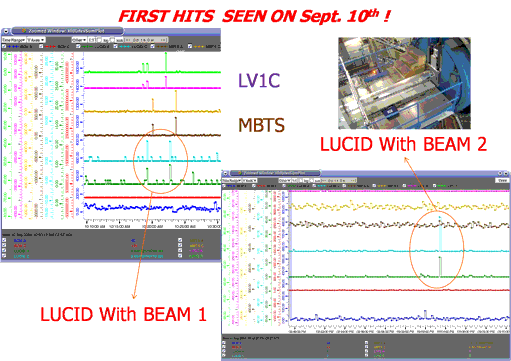
ATLAS e-News
23 February 2011
LUCID: Final stages, first steps
15 September 2008

Detector hit rates as a function of time during the ATLAS splash events on September 10th. The excess in hits counting recorded by LUCID (together with the other detectors) is evident.
LUCID was the final sub-detector to enter the cavern back in June. Tasked with measuring the luminosity of collisions occurring in ATLAS, it nestles next to the beampipe on either side of the detector, 17 metres from the interaction point.
When we last heard from the LUCID team, on July 22nd, they had recently finished installing and were well into their commissioning phase. Speaking in an interview on September 9th, project leader Marco Bruschi brought us up to speed, ahead of Big Bang Day:
“We only had a short time for the commissioning. Our detector is not complicated and it doesn’t have a huge number of channels, but nevertheless there are some critical points, such as the electronics,” he explained. “Following the installation, from June until now, we concentrated on debugging the system, making the calibration, making connections, and then testing the integration on TDAQ and DCS.”
They managed to complete their work under strict time pressures, and were able to integrate with the other sub-detectors in order to take part in whole-system practice data-taking runs. But Marco recalled there being a few bitten nails when it came to the bake-out phase:
“Our detector is right around the beampipe … Of course we had a cooling system in order to preserve the delicate parts – the photomultipliers – but there was one part of the detector which was really supposed to be in the open air during this baking-out period.” In order for the bake-out to be efficient though, the area ended up having to be closed within the shielding, drastically limiting ventilation. “We were a bit worried about the temperatures our cables might reach,” he explained, “but we monitored everything and thankfully we were always safe.”
“Now we are in the game to see the first interactions!” said a confident Marco on the eve of the first beam. “The data that we start taking from tomorrow will be very important in order to understand the level of background that we will detect; from tomorrow, we start our phase of debugging the detector using a physical signal.”
Indeed, this initial phase before the beams are brought into collision is crucial for all the sub-detectors in terms of ascertaining levels of background noise originating from either beam interactions with residual gas in the pipe, or from the beam halo.
LUCID registers one hit every few seconds, due to low-level permanent noise, when there is no beam present. When the first beam passed through ATLAS on September 10th, it registered four hits in one second, in both of its segments. This result was replicated during the subsequent beam tests, and was in agreement with other beam monitor detectors, TMBS and LV1C. The sub-detector also showed a promising response in its other intended role as a trigger element, producing signals in agreement with the Level 1 trigger systems.
In the aftermath of Big Bang Day, Marco is looking forward to the next steps. “The real game is starting now,” he smiles. “We have collected the first data for a beam in the ATLAS environment, and next we’ll need to interpret this to see if it is as expected. We’re working hard to quickly converge on a reliable measurement of the luminosity for ATLAS, and to understand the trigger capabilities of our device and its beam monitor features.”

Ceri PerkinsATLAS e-News |